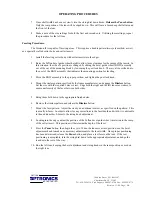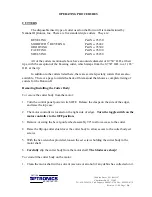
TROUBLESHOOTING
100 Avon Street, P.O. Box 1547
Charlottesville, VA 22902
Tel: 434-295-9126 Tech Support: 800-247-9796 Fax: 888-239-0778
Revision: 11/98 Page -
33
-
NATIONAL
INCORPORATED
the gear lash is properly set, and these marks still occur, the lens drive
assembly should be replaced.
To adjust gear lash:
1.
Locate the Adjustment screw and lock nut in the back of the gear box.
2.
Loosen the lock nut.
3.
Using a 3/16" hex wrench, snug the set screw. DO NOT over tighten
the set screw, apply only finger tip pressure to the hex wrench. Over-
tightening the set screw will bind the motor.
4.
Hold the set screw in place with the hex wrench, to prevent any further
tightening, and retighten the lock nut.
CHIP IN LENS (AT ONE SPOT ON THE LENS. CHIP IS USUALLY TOO DEEP
TO REMOVE ON A HAND WHEEL)-
A.
Bevel Guide Wheel is set too low.
Check to see that the BGW is set in
accordance with the maintenance procedures.
B.
Differential is closing too quickly.
Follow the procedures on
Page 31
for
verifying differential flow rate.
MARKS WHICH APPEAR TO BE SCRATCHES OR INDENTATIONS APPEAR
ON THE FRONT OF THE LENS -
Although these marks appear to come from the Teflon Bevel Guide Wheel,
the Teflon ring itself is soft and self-lubricating and cannot damage a lens at
room temperature. The marks that occur are due to other contributing factors,
most notably heat.
MARKS ON POLYCARBONATE LENSES -
A.
Dull Cutters.
It is important to keep heat build-up to a minimum when
running Polycarbonate lenses. Dull cutters can produce enough heat to soften
the lens and allow the BGW to cause depressions in the substrate beneath the
anti-scratch coating.
B.
A Bad Cutter Motor.
A bad nose bearing in the cutter motor can cause heat
build-up in the same fashion as dull cutters.
C.
Static Electricity.
Heat and humidity changes can cause static electricity to
build up. Static will cause small cut particles to cling to the Teflon ring and
































